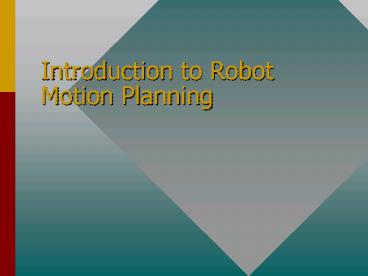Introduction to Robot Motion Planning - PowerPoint PPT Presentation
1 / 19
Title: Introduction to Robot Motion Planning
1
Introduction to Robot Motion Planning
2
Example
- A robot arm is to build an assembly from a set of
parts. - Tasks for the robot
- Grasping position gripper on object
- design a path to this position
- Trasferring determine geometry path for arm
- avoide obstacles clearance
- Positioning
3
Information required
- Knowledge of spatial arrangement of wkspace.
E.g., location of obstacles - Full knowledge full motion planning
- Partial knowledge combine planning and
execution - motion planning collection of problems
4
Basic Problem
- A simplified version of the problem assumes
- Robot is the only moving object in the wkspace
- No dynamics, no temporal issues
- Only non-contact motions
- MP pure geometrical problem
5
Components of BMPP
- A single rigid object - the robot - moving in
Euclidean space W (the wkspace). - W RN, N2,3
- Bi , I1,,q. Rigid objects in W. The obstacles
- Assume
- Geometry of A and Bi is perfectly known
- Location of Bi is known
- No kinematic constraints on A a free flying
object
6
Components of BMPP (cont.)
- The Problem
- - Given an initial position and orientation
- a goal position and orientation
- - Generate continuous path t from initial
postion to goal - t is a continuous sequence
of position and orientation
7
Configuration Space
- Idea represent robot as point in space
- map obstacles into this space
- transform problem from planning object
motion to planning point motion - Notion of CS
- A at a given position is a compact in W.
- attached frame FA
- Bi closed subset of W .
- Fw is a frame fixed in W
8
Notion of CS (cont)
- Def configuration of an object
- Is the position of every point of the object
relative to FW - Configuration q of A is the postion T and
orientation O of FA w.r.t. FW - Def configuration space of A
- Is the space T of all configurations of A
- A(q) subset of W occupied by A at q
- a(q) is a point in A(q)
9
Information Required
- Example T N-dimensional vector
- O NxN rotation matrix
- In this case, q (T,O), a subset of RN(N1)
- Note that C is locally like R3 or R6.
- Notice no global correspondence
10
Notion of Path
- Need a notion of continuity
- Define a distance function d C x C -gt R
- Example
- d(q,q) maxa in A a(q) - a(q)
- Def A path of A from qinit to qgoal
- Is a continuous map t 0,1 -gt C
- s.t. t(0) qinit and t (1) qgoal
- Prop. t is continuous if for each so in (0,1),
lim d(s,so) 0 when s -gt so
11
Obstacles in Configuration Space
- Bi maps in C to a region
- CBi q in C, s.t. A(q) ? Bi ? ?
- Obstacles in C are called C-obstacles.
- C-obstacle region
- Free space Cfree C -
- q is a free configuration if q belongs to Cfree
- Def Free Path.
- Is a path between qinit and qgoal , t 0,1 -gt
Cfree
12
Example of a C-Obstacle
CBi
Bi
- The robot is a triange that translates but not
rotates
13
Obstacles in C (cont.)
- Def Connected Component
- q1, q2 belong to the same connected component
of Cfree iff they are connected by a free path - Objective of Motion Planning generate a free
path between 2 configurations if one exists or
report that no free path exists.
14
Examples of C-Obstacles
- Translational Case
- A is a single point -gt no orientation
- W RN C
- A is a disk or dimensioned object allow to
translate freely but without rotation. - C-Obstacles Are the obstacles grow by the
shape of A
15
Planning Approaches
- 3 approaches road maps, cell decomposition and
potential field - 1- Roadmap
- Captures connectivity of Cfree in a network of
1-D curves called the roadmaps. - Once a roadmap is constructed use a standard
path. - Roadmap Construction Methods 1) Visibility
Graph, 2) Voronoi Diagram, 3) Freeway Net and 4)
Silhouette.
16
a- Visibility Graphs
- Mainly 2-D C-space and polygonal C-obstacles
- qinit , qgoal
- C-obstacle vertices
- b- Retractions Voronoi Diagram
- V.D. set of all configurations whose minimal
distance to C-obstacle region is achieved with at
least 2 points in the boundary of CB
- nodes
17
c. Cell decomposition
- Decompose the robots free space into simple
regions called cells - A path within a cell -gt easy to generate
- Connectivity graph non-directed graph
representing adjacency relation between cells - Nodes cells extracted from free space
- 2 nodes connected by a link iff cells are
adjacent - channel resulting sequence of links
- Cell Decomp Exact or Approximate
18
d- Potential Fields
- In principle, we can discretize the C - space by
using a greed. Then search for path. - Computational expensive gt need heuristics.
Example of heuristics potential fields - Idea robot attracted by qgoal and repulsed
by CBis - Potential methods can be very efficient, but
- Can be trapped in local minima!
19
Interaction with Sensing
- Robot with no prior knowledge about environment
cannot plan - Instead, rely on sensory information
- E.g., robot with proximity sensor can attempt to
create repulsive potential. This can result on
falling into local minima. - Absence of info reactive scheme due to Lumelsky.
Algorithm guaranteed to reach qgoal whenever C
-obstacles are bounded by a simple closed curve
of finite length - Works in 2-D































